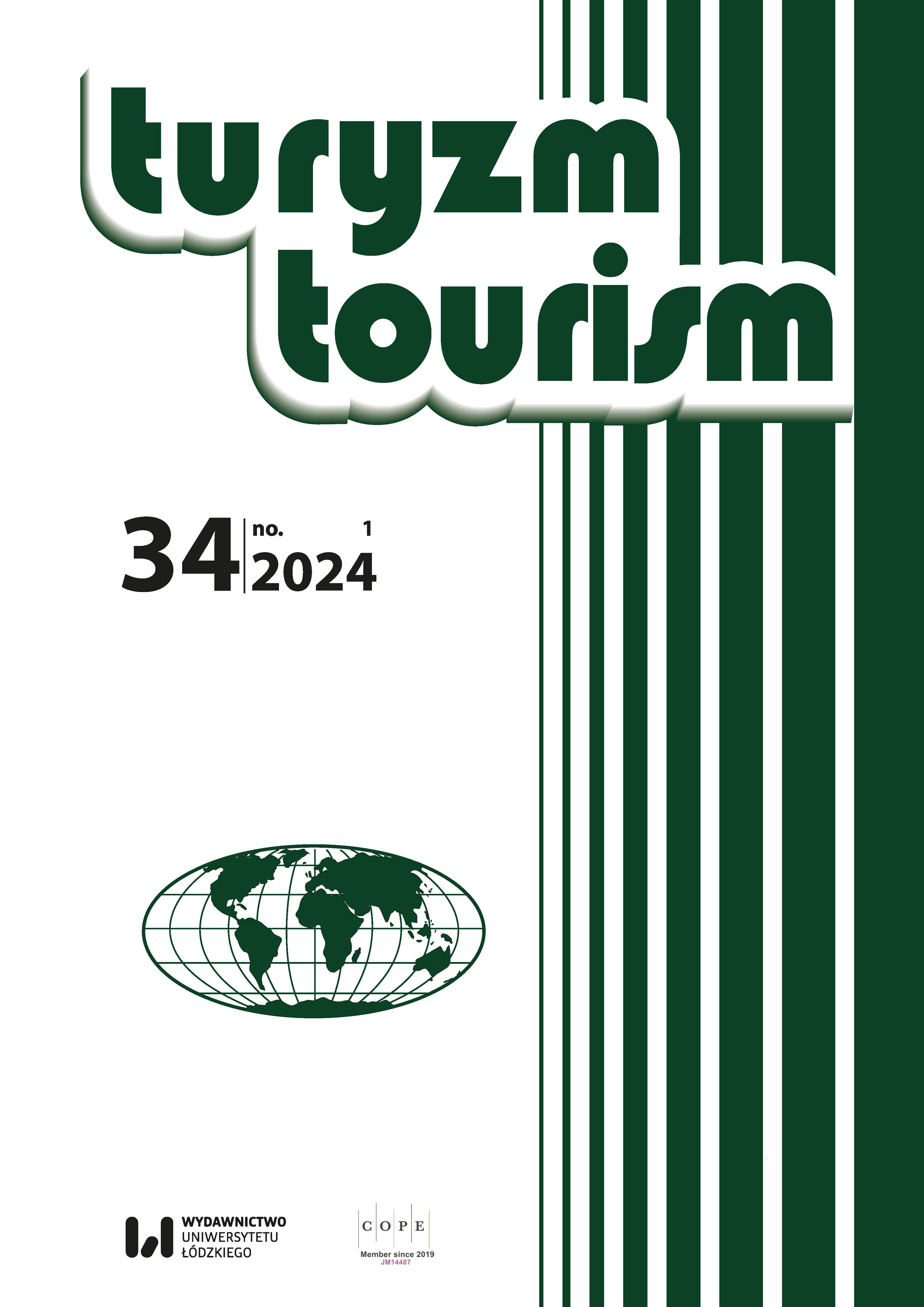Cyfrowe mapowanie miejsc turystycznych w Bangka Regency w oparciu o model turystyki wellness
DOI:
https://doi.org/10.18778/0867-5856.34.1.06Słowa kluczowe:
wellness tourism, scalogram analysis, tourism destinationAbstrakt
Rozwój turystyki w prowincji Bangka Belitung został utrudniony przez globalne rozprzestrzenianie się pandemii Covid-19. Przed pandemią liczba turystów w województwie do 2019 roku rosła i budziła optymizm co do rozwoju turystyki. Jednak turystyka Bangka Belitung pogrążyła się w drastycznym spadku w 2020 r. Turystyka wellness to model podróży, który oferuje zapobiegawcze i alternatywne możliwości, zwracając uwagę na zdrowie i dobre samopoczucie podczas podróży. System wykorzystuje platformy cyfrowe i zasięg cyfrowy w celu ułatwienia wzajemnych połączeń i interaktywności między społecznościami lokalnymi, krajowymi i globalnymi. Cyfryzacja była szeroko przeprowadzana przez podmioty gospodarcze i interesariuszy turystyki w ramach odbudowy i rozwoju turystyki. W badaniu tym przeanalizowano cyfryzację turystyki wellness w miejscowościach turystycznych Bangka Regency. Metoda zastosowana w tych badaniach obejmowała obserwację, wywiad, ankietę i badanie literatury. Analiza danych została przeprowadzona przy użyciu podejścia turystyki wellness, analizy skalogramu i analizy GIS (Geographic Information System). Próba badawcza składała się z 14 destynacji turystycznych w Bangka Regency. Wyniki analizy wykazały, że 100 procent miejsc turystycznych w Bangka Regency wdrożyło protokół zdrowotny, podczas gdy najniższy wynik uzyskano we wskaźniku atrakcji. Analiza skalogramu wykazała, że 35,71 procent destynacji turystycznych Bangka Regency znajduje się w Ordo I, co oznacza, że mają one pełne zaplecze.
Słowa kluczowe: Turystyka wellness, analiza skalogramów, kierunek turystyczny
Pobrania
Bibliografia
Badan Pusat Statistik. (2021, December). The number of hotel guest visits to the Province of the Bangka Belitung Islands in December 2021 was 48,086 visits. BPS Bangka Belitung Province. https://babel.bps.go.id/pressrelease/2022/02/02/891/jumlah-kunjungan-tamu-hotel-ke-provinsi-kepulauan-bangka-belitung-desember-2021-sebesar-48-086-kunjungan-.html
Google Scholar
Chen, K.-H., Chang, F.-H., & Tung, K.-X. (2014). Measuring wellness-related lifestyles for local tourists in Taiwan. Tourism Analysis, 19(3), 369–376. https://doi.org/10.3727/108354214X14029467968682
Google Scholar
DOI: https://doi.org/10.3727/108354214X14029467968682
de la Barre, K., de la Barre, S., & Taggart, M. (2005, May). A feasibility study for a Yukon health and wellness industry. North to Knowledge, Learning Travel Product Club, and The Department of Tourism and Culture, Yukon Territorial Government. https://silo.tips/download/a-feasibility-study-for-a-yukon-health-and-wellness-tourism-industry
Google Scholar
Han, H., Kiatkawsin, K., Koo, B., & Kim, W. (2020). Thai wellness tourism and quality: Comparison between Chinese and American visitors’ behaviors. Asia Pacific Journal of Tourism Research, 25(4), 424–440. https://doi.org/10.1080/10941665.2020.1737551
Google Scholar
DOI: https://doi.org/10.1080/10941665.2020.1737551
Ismiwati, B., & Sayuti, M. (2019). Penentuan pusat-pusat pertumbuhan dan wilayah pendukungnya sebagai upaya pengembangan wilayah di Kabupaten Lombok Barat, Nusa Tenggara Barat. Jurnal Kompetitif: Media Informasi Ekonomi Pembangunan, Manajemen dan Akuntansi, 5(2), 69–82. https://e-journal.unizar.ac.id/index.php/kompetitif/article/view/149
Google Scholar
Khuong, M.N., & Phuong, N.T. (2017). The effects of destination image, perceived value and service quality on tourist satisfaction and word-of-mouth: A study in Ho Chi Minh City, Vietnam. International Journal of Trade, Economics and Finance, 8(5), 217–224. https://doi.org/10.18178/ijtef.2017.8.5.568
Google Scholar
DOI: https://doi.org/10.18178/ijtef.2017.8.5.568
Luthfiani, A.D., & Suryani, A.W. (2022). The impact of voluntary and involuntary intellectual capital disclosure on firm value. The Indonesian Journal of Accounting Research, 25(1), 49–82. https://doi.org/10.33312/ijar.593
Google Scholar
DOI: https://doi.org/10.33312/ijar.593
Mueller, H., & Kaufmann, E.L. (2007). Wellness tourism: Market analysis of a special health tourism segment and implications for the hotel industry. Journal of Vacation Marketing, 7(1), 5–17. https://doi.org/10.1177/135676670100700101
Google Scholar
DOI: https://doi.org/10.1177/135676670100700101
Nandya, A.F. (2016). Identifikasi pusat pertumbuhan dan wilayah hinterland di Kabupaten Sleman. Universitas Islam Indonesia. https://dspace.uii.ac.id/handle/123456789/5996
Google Scholar
Nawijn, J., & Filep, S. (2016). Two directions for future tourist well- being research. Annals of Tourism Research, 61, 221–223. https://doi.org/10.1016/j.annals.2016.07.007
Google Scholar
DOI: https://doi.org/10.1016/j.annals.2016.07.007
Page, S.J., Hartwell, H., Johns, N., Fyall, A., Ladkin, A., & Hemingway, A. (2017). Case study: Wellness, tourism and small business development in a UK coastal resort: Public engagement in practice. Tourism Management, 60, 466–477. https://doi.org/10.1016/j.tourman.2016.12.014
Google Scholar
DOI: https://doi.org/10.1016/j.tourman.2016.12.014
Pandža Bajs, I. (2015). Tourist perceived value, relationship to satisfaction, and behavioral intentions: The example of the Croatian tourist destination Dubrovnik. Journal of Travel Research, 54(1), 122–134. https://doi.org/10.1177/0047287513513158
Google Scholar
DOI: https://doi.org/10.1177/0047287513513158
Pramono, J. (2013). Strategi pengembangan health and wellness di Bali. Matrik: Jurnal Manajemen, Strategi Bisnis dan Kewirausahaan, 7(1), 66–74. https://ojs.unud.ac.id/index.php/jmbk/article/view/6074
Google Scholar
Pyke, S., Hartwell, H., Blake, A., & Hemingway, A. (2016). Exploring well-being as a tourism product resource. Tourism Management, 55, 94–105. https://doi.org/10.1016/j.tourman.2016.02.004
Google Scholar
DOI: https://doi.org/10.1016/j.tourman.2016.02.004
Reitsamer, B.F., & Brunner-Sperdin, A. (2017). Tourist destination perception and well-being: What makes a destination attractive? Journal of Vacation Marketing, 23(1), 55–72. https://doi.org/10.1177/1356766715615914
Google Scholar
DOI: https://doi.org/10.1177/1356766715615914
Ritpanitchajchaval, N., Ashton, A.S., & Apollo, M. (2023). Eudaimonic well-being development: Motives driving mountain-based adventure tourism. Journal of Outdoor Recreation and Tourism, 42, Article 100607. https://doi.org/10.1016/j.jort.2023.100607
Google Scholar
DOI: https://doi.org/10.1016/j.jort.2023.100607
Singh, R., Manhas, P.S., Mir, M.A., & Quintela, J.A. (2022). Investigating the relationship between experience, well-being, and loyalty: A study of wellness tourists. Administrative Sciences, 12(3), Article 98. https://doi.org/10.3390/admsci12030098
Google Scholar
DOI: https://doi.org/10.3390/admsci12030098
Smith, M., Deery, M., & Puzko, L. (2010). The role of health, wellness and tourism for destination development. Journal of Hospitality and Tourism Management, 17(1), 94–95. https://doi.org/10.1375/jhtm.17.1.94
Google Scholar
DOI: https://doi.org/10.1375/jhtm.17.1.94
Thawornwiriyatrakul, W., & Meeprom, S. (2020). Antecedents of tourist loyalty in health and wellness tourism: The impact of travel motives, perceived service quality, and satisfaction. International Journal of Innovation, Creativity and Change, 11(10), 300–315. https://ijicc.net/images/vol11iss10/111029_Thawornwiriyatrakul_2020_E_R.pdf
Google Scholar
Valeriani, D., Prihardini Wibawa, D., & Safitri, R. (2021). Stakeholders analysis in tourism industry recovery in Bangka Regency during new normal period. American Journal of Humanities and Social Sciences Research (AJHSSR), 5(7), 307–317. https://www.ajhssr.com/wp-content/uploads/2021/07/ZK2157307317.pdf
Google Scholar
Pobrania
Opublikowane
Jak cytować
Numer
Dział
Licencja

Utwór dostępny jest na licencji Creative Commons Uznanie autorstwa – Użycie niekomercyjne – Bez utworów zależnych 4.0 Międzynarodowe.










